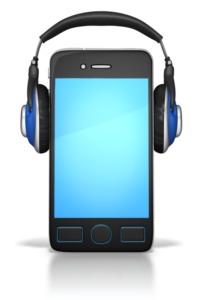Podcast Assignment for the Social Work Classroom
Editor’s Note: This blog post shares information about a podcast assignment developed and implemented in multiple social work classrooms over the past year. This assignment is a collaboration between myself and Melanie Sage, Todd Sage & Michael Lynch of the University at Buffalo’s School of Social Work. We share a copy of the assignment and rubric along with information about why social work educators might want to try this assignment in their own classroom.

Podcasts are now a well-known part of social work education. With so many different types of social work podcasts, it is easy for an educator to assign a podcast instead of an article, asking students to listen instead of reading. Examples of podcasts designed specifically for social work include:
- The Social Work Podcast by Dr. Jonathan Singer
- inSocial Work Podcast Series by the University at Buffalo’s School of Social Work
For a more comprehensive list of podcasts, check out this blog post written by one of us (Melanie):
Briefly, a podcast is an audio file made available on the Internet for downloading to a portable media player, computer, or other device. Podcasts are easy to create and do not require many technical skills which making the technology a good fit for student assignment and for faculty who do not have a lot of technology experience. One of us (Laurel) has been using and writing about podcast assignments for several years. Here are links to a series of posts she wrote back in 2014 when she first started using podcasts in her classroom:
- Podcasting for Social Work Students, Part 1 – Describing the Assignment
- Podcasting for Social Work Students, Part 2 – Why use podcasting in the classroom
- Podcasting for Social Work Students, Part 3 – Advice for designing the assignment from Jonathan Singer
Jump to today, the four of us decided to collaborate on a project to assess our students’ learning outcomes with a podcast assignment as well as find out if they actually liked podcasting better than a traditional social work assignment (i.e. writing a paper or giving a presentation). We started by creating a podcast assignment that could be modified for different types of social work classes, including policy, research and practice courses. We are sharing this assignment here so that anyone can incorporate it into their courses.
Social Work Podcast Assignment Instructions:
The purpose of this assignment is to help students learn about assessment, evaluation, and/or intervention skills while also learning about technology tools and resources that will help them be informed about social work practice. In this assignment you will also demonstrate your ability to present yourself in a professional manner, self-awareness, and ability to engage in critical peer consultation.
An audio podcast is a digital audio file made available on the Internet for downloading to a portable media player, computer, or other device. The content of a podcast can inspire, inform, or entertain an audience. An audio format can be used as a way to capture people’s attention and direct their concern to the topic you cover in ways that you cannot do in writing. You will save your audio file in an mp3 or mp4 format, which is the default for most recording devices.
Before you record, edit, and upload your podcast, you will:
- Listen to a podcast in class and rate it using the attached rubric
- Review, in class, features of good podcasts, storytelling, and basic audio equipment use
- Try out your recording device during a class period and review the audio with a peer for clarity
- Review, for homework, YouTube videos related to creating podcasts
- Listen to a podcast for homework that is similar to the type of podcast you will create, and create a reflection post that describes and assesses the criteria for interview/storytelling quality, sound quality, editing quality, and content quality.
- Choose a topic, audience, and interview or discussion guide for your podcast. Draft your narrative: what’s the story you want to tell? What do you imagine will flow from this story? What will listeners want to know about your topic? How will you elicit or develop this information?
For your podcast (you can include your class specific information in this paragraph), you will either interview someone about a topic relevant to families, discuss a topic relevant to families with a peer/s (up to 3 people), or present on a topic relevant to families. The content should educate listeners on the issue, increase listener empathy related to the topic, and be engaging storytelling. The tone should be professional casual. Do not read a script. The audience will be your class peers, but should also include an external group (social work students generally, clinical practitioners, members of a specific community, etc).
The podcast assignment has two parts:
- Create a podcast between 15-20 minutes in length, including the introduction.
- The intro should be 1-4 minutes and identify you (name and your role as a social work student), and any other people, include the date of the recording, and explain what is talked about during the podcast. It should also mention any distractions (that can’t be edited out) that happen during the podcast. You might also discuss background or relevance of the topic to social work, and what audience might benefit from listening. For best results, this should be created after the podcast is recorded.
- If you are conducting an interview, questions should help weave a story. If you are not interviewing, your narrative should still help weave a story. See story arc presentation handout.
- The podcast should end with a thank you (if interview) or other clear ending (where to find more information on the topic, etc.)
- Interview should be edited to cut distractions where possible, pauses, and add a very short (a few sec) intro/exit music or other appropriate sounds that enhance the recording.
- If you have external references, mention the website/article/etc as “show notes” which will be posted alongside your podcast if shared widely.
- Have a peer review your podcast using the attached rubric. After the review, you may choose to re-record or edit any part of the podcast to address changes. Complete the reflection portion of your assignment. Your reflection should answer these questions: (a) what did it take to create your podcast; (b) what did you learn from creating the podcast, about technology and your topic; (c) how is podcasting similar and different to writing a paper on the topic; (d) how will you use podcasts in the future; (e) if you worked with a partner, describe how you divided the work and who did what.
For a copy of the rubric: Rubric for Social Work Podcast Assignment
Podcast Assignment Checklist:
_______ Audio release signed by all parties attached
_______ File uploaded as an mp3 or mp4
_______Peer review attached
_______Reflection assignment completed
Interview tips:

- Review your questions, topic, and interview plan before you begin, but avoid reading from your notes. Before you start your recording, chat casually about the topic with anyone who will also be part of the recording to help relax and get comfortable with the topic. Test your audio right before recording.
- Interview should not contain sensitive subjects that would cause discomfort if shared widely. Interviewee must minimally agree to share podcast with class, with public sharing optional.
- If you make a mistake, pause for a few seconds and then restart from before you made the mistake. This way it will be easier to find your error and delete it from the audio file.
Quality Recording Tips:

- Keep microphone near speakers’ mouths- this may mean propping it up on something. Point the bottom of the phone (mouth piece) toward the speakers. If you are recording your own voice you can use the phone mouthpiece or even the headphones that have a built-in mic (like the ones that come with an iPhone) for better quality. Do not move mic back and forth while speaking.
- Do not touch microphone/recording device during recording.
- Do not record in too big of a room- acoustics are better in a small space. Consider reserving a private room in a library or using a space in a home when nobody but your interviewee is there. If your interview is in a public place (for a good reason, such as interviewing someone you don’t know), cut in an audio track to explain where you were and why it is noisy before the interview starts. Avoid rooms with running fans or other distracting background noise.
Equipment:
- Microphone or cell phone
- Cell phone can be used stand-alone by speaking into speaking end of phone
- You can use either the “voice memos” or built-in recording device, or an app such as GarageBand, VoiceRecorder, or RecorderPlus
- Lavalier microphones that pin to shirt can be purchased cheaply on amazon or ebay ($12 each) and a splitter (to use two at once) costs $7-20. You can also use headphones that have in-line mics. University libraries often have high quality mics available for checkout.
- Free software (Audacity, GarageBand) allows you to upload your audio content and edit it.
- Free music for intros/etc. is available at https://www.instantmusicnow.com/
Instructor notes: We recommend that you review these resources from National Public Radio (NPR) in class:
- How audio stories begin: https://training.npr.org/audio/how-audio-stories-begin/
- Understanding story structure in 4 drawings: https://training.npr.org/audio/understanding-story-structure-in-4-drawings/
- Listen to a short podcast in class, and then score it as a group using the assignment rubric. Here is one we used in our classes:
- These Days, Family Trees Look More Like A Forest (16-minutes): https://www.npr.org/2011/07/05/137627840/these-days-family-trees-look-more-like-a-forest)
To assess the quality of this assignment, we asked students to complete a post assignment survey for extra credit. If you are interested in this survey, please reach out to Laurel at lihitch@uab.edu.
Are you using podcast assignments in your class? If so, please share your tips and suggestions in the comments below.
How to Cite this Post:
Hitchcock, L.I, Sage, M., Sage, T. & Lynch, M. (2019, January 15). Podcast Assignment for the Social Work Classroom [Blog Post]. Retrieved from: https://laureliversonhitchcock.org/2020/01/15/podcast-assignment-for-the-social-work-classroom/


